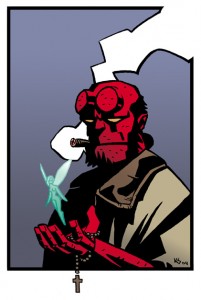Horror is subjective. What you find silly might scare me and vice versa. I refuse to watch slasher films like Halloween or Freddy because I know they’ll give me nightmares; most people I know find those same movies laughable. Imagery, gore, violence, the supernatural – we all react to them differently. I can’t read books by Stephen King, but I’m okay with reading crime or suspense stories. I can’t read the new Animal Man comics despite digging the story because the art burns into my brain and pops to the front of my mind at the weirdest times – and not in a good way. It’s the only comic I’ve had to stop reading just because I was too creeped out.
So far.
Comics, more than any other medium, allow me to experience the fun of being spooked without feeling like I have to hide behind a blanket or sleep with the light on. I can read something like Hellboy or Locke and Key at night and not freak out. That might not seem like anything remarkable to most of you, but look: I can’t even watch Supernatural by myself after dark.
Comics let me be scared and not terrified, and I like it. I don’t necessarily understand how horror comics are somehow safe for my brain. If anything, you’d think it would be worse because there are images but I’ll take it.
I like more when horror is about an overall feeling and not so much about the jump factor. You can be surprised by a comic; there’s going to be a moment when the person with the weapon leaps out from a dark corner but it doesn’t hit you the same way as it does when you’re watching a TV show or movie. In comics, it’s all about the mood and atmosphere. The art and color palette make all the difference for me. I’m less likely to feel the right vibes if the panels are filled with bright yellows and blues.
I think Hellboy is perfect example of the perfect tone, and Mike Mignola does it with just one panel. He excels at making things look ominous. He draws a tree branch, and it’s eerie. I saw Mignola on a panel about horror in comics at WonderCon last year, and I recall him saying that his distinct style is a conscious effort. There’s a lot of black areas in the artwork, and that’s intentional because the more that’s unseen, the scarier it is. Horror is more effective when the monster is hidden. We’re more frightened by the unknown.
That’s perfect for the supernatural. Hellboy and the rest of the B.P.R.D. face the fantastical. The settings include abandoned houses, graveyards, or barren locales. Every piece of art in those panels – a worn door that you can tell makes creaky sounds, a tombstone, a bird, fire – they all evoke auras of creepy. The negative space packs an equal punch. It’s like Mignola and colorist Dave Stewart have a particular setting they can turn on that gives everything an instant horror filter (that needs to be an iPhone app). I’m sure they’ve worked hard to develop those skills, and it shows.
And I love how Hellboy’s adventures draw on some of the stories we know. The concept of Baba Yaga and her house on chicken legs has always given me chills, but Mignola’s interpretation of her in Wake the Devil freaked me out. Familiar fairy tales or characters from legend and myth are twisted into a new stories. Hellboy has humor, suspense, action – it’s all wonderful and pretty freaking spooky. And the best part is that I look forward to sitting down with Hellboy books instead of hiding them in the freezer – that’s how I like to enjoy horror.




Comments are closed.